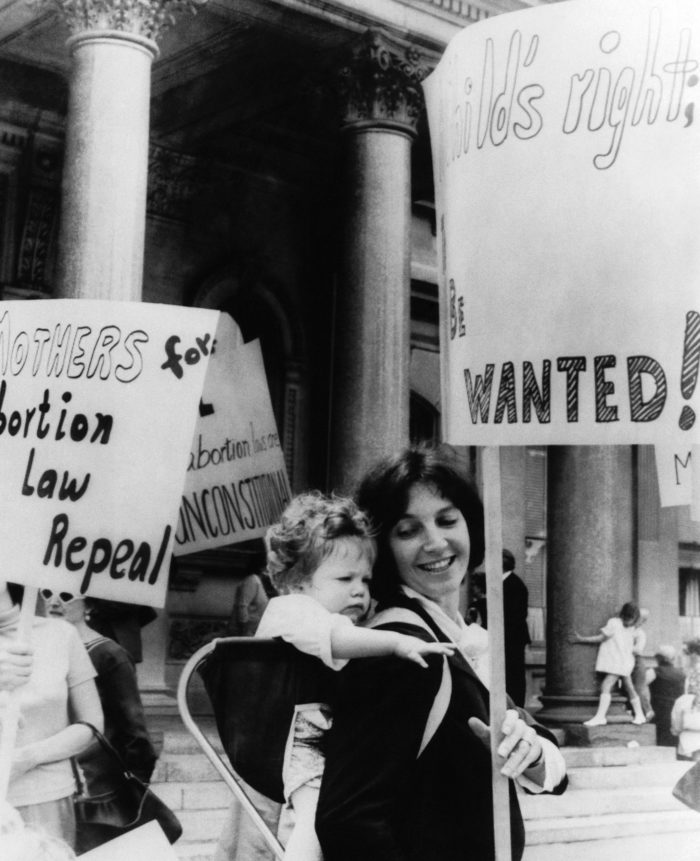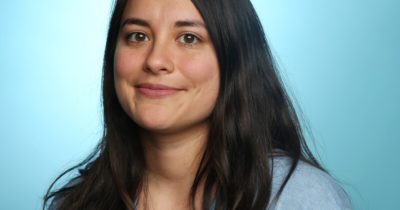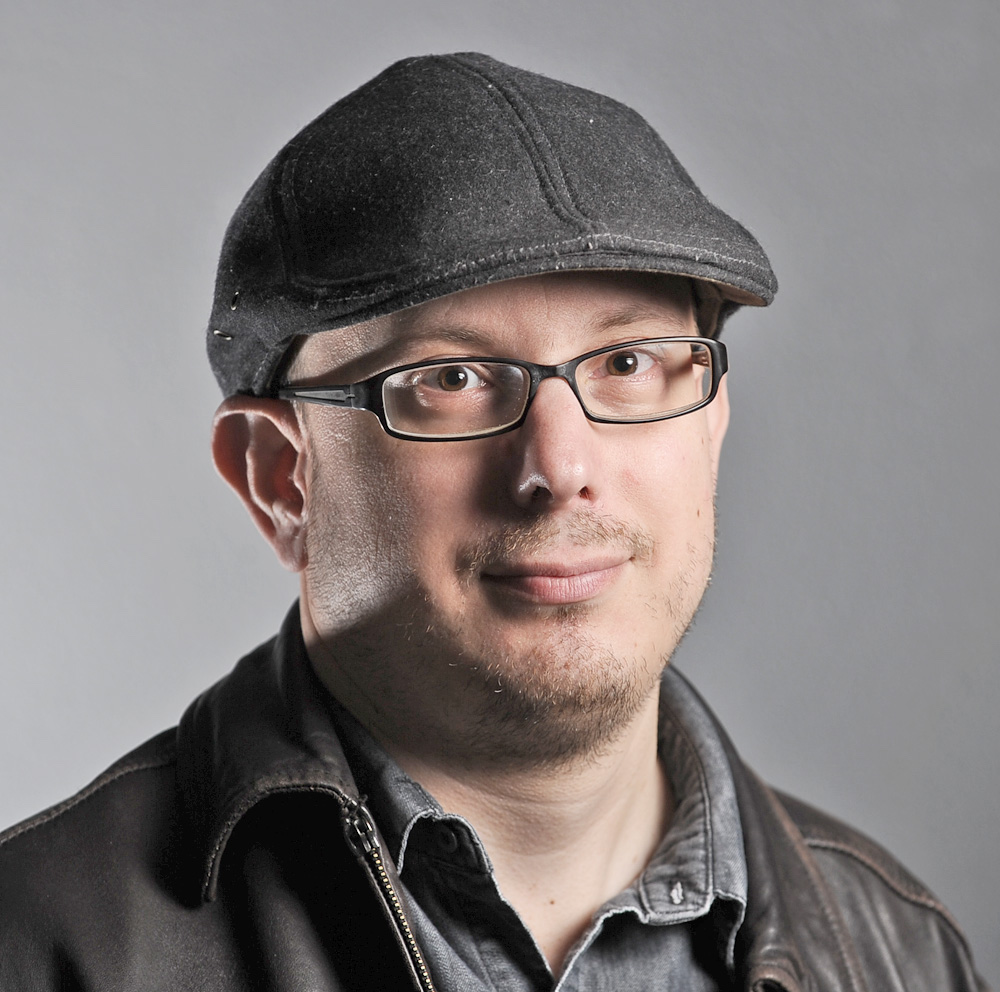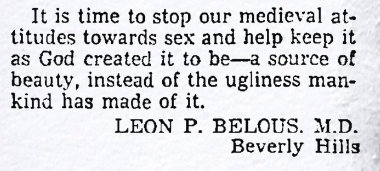
Mrs. Carl Anderson of Princeton carries her 9-month-old daughter at an abortion rights rally in New Jersey in 1969.
People v. Belous was a 1969 California Supreme Court case foundational to the 1973 Roe v. Wade ruling, in which the U.S. Supreme Court codified the constitutional right to an abortion. Mejia’s story, “Her illegal abortion paved the way for Roe,” was written 56 years after a college student named Cheryl Bryant had an abortion, which was illegal at the time. It does what the best historical narratives do: sweeps cobwebs from the past so readers can better understand the present they live in.
The story traces the travails faced by Bryant and her boyfriend Clifton Palmer, both “poor as church mice,” who felt cornered out of a future when Bryant became pregnant. They wound through a maze of dead-end options before they found a solution. After the abortion, they went on to graduate, marry and raise a family. Bryant had a career in teaching, Palmer as a school psychologist and then minister. Palmer adopted Bryant’s son from a teen pregnancy and they later had another son. They now live on their hobby ranch in Montana. As Palmer told Mejia in an interview:
“I think you make your choices as best you can in the moment. And then you look forward and you don’t regret anything that’s happened to you.”
But the story goes deeper than the couple’s memories. It also profiles Dr. Leon Belous, a California physician and abortions-right advocate whose conviction for aiding the abortion was overturned by the state Supreme Court after three years of appeals. Belous refused to perform abortions himself, but sometimes referred women to a trained, underground physician rather than have them resort to “butchery” on their own or in Tijuana. In one of his many letters to the press at the time, Belous wrote:
Belous died in 1988, so his story is told through documents and interviews with his granddaughter, Amy Stone. She was born a few years after her mother, as a 1950s college student with little access to birth control, had an abortion with Belous’ support.
Mejia outlines how the Belous case led to changes in California abortion laws, then traces it forward to Texas, where two lawyers were building the case that led to Roe. Linda Coffee, one of the lawyers, “would later refer to People vs. Belous as ‘the most pertinent case I reviewed.’” While the story doesn’t shortchange historical context, it also sparkles with in-the-moment scenes: the details of Bryant’s procedure, such as the Coca-Cola the doctor gave her afterward to settle her stomach; later, the rock a stranger threw through Belous’ window, a threatening note attached with twine.

Brittny Mejia
A story packed with so much context, detail and emotion takes multiple levels of reporting. Mejia flew to Montana to interview the couple at the center of the story; she requested archival and legal documents; she worked on a shortened timeline because of the abortion case before the Supreme Court this summer. ( Her notes topped 38,000 words.
Along the way, lessons emerged that Mejia said she will carry into future stories.
“I think my biggest advice is to take this all a step at a time,” she told me. “Initially, I had so many notes and historical documents that the process felt too daunting. But I went piece by piece and when I couldn’t think through one section, I moved to another one where I felt I could flow more on it.”
Mejia’s interview with Storyboard on the reporting, writing and editing of her story follows. It’s been edited for length and clarity.
Give us the overview of how this story conceived, reported and written.
In May, I covered a press conference that California Gov. Gavin Newsom held regarding the potential U.S. Supreme Court ruling that would overturn federal abortion protections under Roe v. Wade. From there, I started to wonder about the history of abortion in California. As I researched, I came across a case I’d never heard of before: People vs. Belous.
The case involved a young California couple who, in 1966, sought an abortion. At the time, abortion was only legal in cases where it would preserve a woman’s life. The couple – Cheryl and Clifton Palmer – went to a renowned doctor, Leon P. Belous, who gave them the number of a Mexican doctor working in California. After the abortion, the police held the couple for questioning and arrested Dr. Belous and the doctor who had performed the abortion. The case eventually landed before the U.S. Supreme Court.
I wondered what happened to Cheryl and Clifton and tracked them down at their home in Montana, and flew there with photographer Irfan Khan. I later tracked down Amy Stone, the granddaughter of Dr. Belous. The reporting process was lengthy — six weeks from the time I contacted the Palmers until the story was published. I requested records from the California State Archives and from the L.A. Superior Court. I got lucky that Amy Stone had transcripts from the initial proceedings so many years later. That allowed me to recreate the events through actual testimony from Cheryl and Clifton.
As far as the writing, my editor, Maria La Ganga, and I initially had a different idea of how to go. But as I started to write, I changed my mind on how to structure some of the sections. I kept in close contact with Maria throughout the process and sent her way too many versions to look at to see if I was on the right track.
This story would have been relevant to the nation’s legal and policy history even if Roe had been upheld, but as it happens it was published after that precedent was overturned this June in Dobbs v. Jackson. Was the story purposefully held to publish after that decision was released?
This story was supposed to run before the decision was released. But we were prepared for the possibility and knew we’d need to pivot quickly to run the story as soon as the decision dropped. I’d already gone through the fact-checking process and the story had gone through the copy desk, but we had to scramble with the other elements, like the video.
The previous story you discussed with Storyboard — a day in the life of a supermarket as the nation was buckled under COVID — had its specific challenges. But the breadth of sources you had to explore for this story was broader. You cite legal decisions and historical articles, and probe memories of decades-old events. What was the greatest challenge in reporting, and what did you learn from it?
I think my biggest lesson is that it’s always worth it to request records. I was working on a short timeline for this story, but I didn’t let that deter me from putting in records requests. I got back fascinating court testimony from Dr. Belous that I am hoping to use if I decide to write a book about this case. I also asked Belous’ granddaughter about what documents she might have. Those were invaluable in my reconstruction of the lead-up to the 1966 abortion and what came after.
Also, I am so appreciative of the library staff we have at our newspaper. Scott Wilson, one of the paper’s researchers, helped track down news articles from the 1960s. I combed through our historical archives and tracked down pieces we’d written at the time.
I think the biggest challenge was the fact-checking process. When I fact-check a piece, I sit down and highlight every single word as I go through the piece to make sure it’s accurate. It’s tedious, but worth it.
I want to ask about one particular resource: a 1963 panel Dr. Belous sat on, during which another panelist said abortion “promotes promiscuity.” I was struck by how keenly that captured the debate at the time. How did you find that particular resource?
I give all of the credit on that to my colleague Jackeline Luna. She was putting together the video to go with the story and messaged me about finding that panel. I shared it with Amy, Dr. Belous’ granddaughter, who was so moved to be able to hear him speak. The panel was perfect to describe the environment at the time and to illustrate what Belous was up against.
Was there any detail you learned in the course of reporting that jumped out to you in particular?
YES! The fact that the local police had an abortion detail is something that still sticks with me months after reporting this story. Hospitals were required to report cases of illegal abortions to the police, which the abortion detail then dug into. That’s something I want to continue looking into and have put in records requests to the Los Angeles Police Department.
Cheryl’s vivid recollections are a crucial part of the piece. Tell me about how you found and reached out to her and Cliff, and what the interview process with them was like.
I pitched this idea to my editor before I had even made contact with Cheryl and Cliff. I tried to reach them initially with a phone number that had been disconnected. I sent out emails to what I hoped were their email accounts. Then I came across a website they’d created about their horses and was able to track down a current phone number.
When I first called, Cliff seemed unsure what I was talking about and I worried I’d called the wrong people. But as I detailed more, the pieces clicked! They were very surprised to hear from me, but were kind and gracious from the start. They shared photo albums from throughout their lives, which included a newspaper clipping from when they got married in 1966. I also sent them articles from that time frame and later shared the court testimony with them. It was interesting how, at times, their memories differed from what they’d initially testified. So much time had passed that they’d forgotten certain things. That’s why it was so helpful to have the testimony, too.
… that said, the piece also serves as a profile of Dr. Belous. Obviously this presents a different challenge as he’s no longer alive to add his own voice. How did you research him?
I dug a lot through our LA Times archives and found that Dr. Belous had written several op-eds over the years, dating back to the 1950s. He wrote about his concerns about pollution, but that gradually shifted to his focus on legalizing abortion. It was great being able to describe his feelings about abortion utilizing his own words. Also, tracking down his granddaughter really brought him to life. He was the type of grandfather who had open and honest conversations and didn’t shy away from difficult topics..
There’s an emphasis in your story on the California Supreme Court decision’s later importance to Roe v. Wade, but not so much to pull emphasis from the “California” part of the story. Did you originally put more or less emphasis on Roe, or did it remain consistent through writing and editing?
My editor was very helpful in cutting down some of the history that was unnecessary. Another editor took a look later and asked for a line higher up that clearly stated the significance of People v. Belous for Roe v. Wade.
Did the story structure change during writing and editing?
When I first talked through the story with my editor, we both envisioned a different structure. I wrote up an outline and tried to shape the story that way. But as I started to piece everything together, I realized that structure no longer worked. The moment I started changing it, I actually called my editor to run it by her and she loved it.
I must have annoyed her through this process, though, because I kept sending sections piecemeal to get her to weigh in on it. Finally, halfway through, I told myself I needed to just send her the finalized version. The story felt so ambitious that I wanted to make sure I was on the right track.
In addition to the Times story, there’s a striking video. How much participation did you have, and what was that process like?
I LOVE this video. I worked closely with Jackeline Luna trying to dig up news articles and any other historical details that could be useful. I shared audio and videos Irfan Khan and I had shot while out together and also sat down for a video interview with Amy Stone. The process was incredibly stressful for Jackie and the rest of the team because we were working on such a tight deadline.
What reaction have you received?
I’ve had people email me and tweet that they’d never heard about this California story. I had relatives of Belous reaching out and asking me if they could be put in touch with Belous’ granddaughter. I also had a television and film producer/writer reach out to me, interested in possibly turning the story into a multipart series or a documentary. I love history stories, because I think it’s important that we remember the past.



